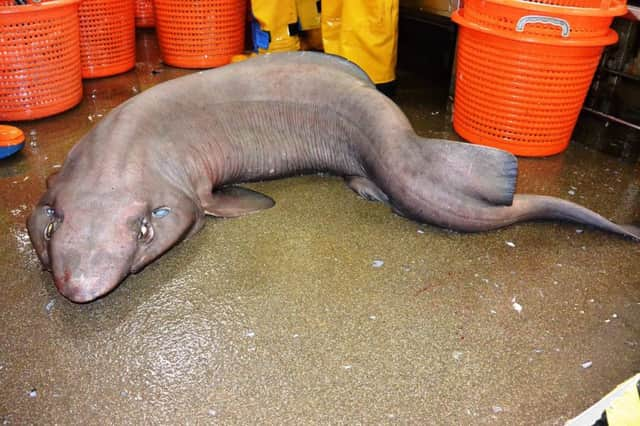Rare “sofa shark” found off Hebrides


A sofa shark measuring more than two metres long was caught by marine biologists during a deep-sea survey near the remote islands of Barra and St Kilda.
The fish, properly known as a false catshark, gets its nickname because of its flabby features.
Advertisement
Hide AdAdvertisement
Hide AdIt has been likened to a blobfish, which was recently voted the world’s ugliest animal.
A picture taken of it on the boat shows its distinctive narrow feline eyes, big mouth and broad head with a short, rounded snout.
The unusual creature is only the second of its kind to be spotted in over a decade in British waters.
It was found by scientists carrying out research work for government agency Marine Scotland in the Outer Hebrides.
It was identified as a female and weighed almost 60kg - more than double the weight of the only other catshark recorded north of the border, seen near the same area 15 years ago.
The shark was an unexpected discovery for scientists during the survey.
Marine biologist Francis Neat said: “I was pretty surprised when it landed in our boat.
“We quickly measured and weighed it before sending it back into the water.
“We hadn’t seen one in ten years.
Advertisement
Hide AdAdvertisement
Hide Ad“It’s not unique to Scotland but it’s certainly interesting to look at - it’s a big and baggy-looking creature.
“It looks a lot like a soft, discarded sofa when it’s just lying there.”
The latest sighting brings the total number of shark species living in Scottish waters to 72.
A spokesman for the Scottish Shark Tagging programme said it was a welcome addition to the list.
“We have never seen this type of shark in Scotland before and it’s great to add it to our long list of species in Scotland,” he said.
“Not too long ago we were told that there were only 32 different types of shark in Scottish waters, but in the past year we have learned that there are actually 72 different species, many of which are in deep water.”
Environment secretary Richard Lochhead was also delighted that the shark had been spotted.
He said: “It is great to see such a rare shark in Scottish waters, which has only been spotted here once before.
Advertisement
Hide AdAdvertisement
Hide Ad“The false catshark was previously encountered back in 2000 by Marine Scotland Scientists whilst they were carrying out a survey just north of Vidal Bank.”
Both sofa sharks were caught within several miles of each other on the same part of the shelf slope north of Vidal Bank, 50 miles south-west from the Isle of Barra.
The animal caught in 2000 was 183cm long and weighed 25kg.
The heavy-bodied shark, which can grow up to 3m long and 125kg in weight, can be readily identified by its elongated, keel-like first dorsal fin.
It has long, narrow eyes and a large mouth lined with more than 200 rows of tiny teeth in each jaw.
It is usually dark brown in colour, though some – like the latest example – are light gray.
A deep-water species, it is usually found at depths between 500m and 1,400m. However, it has been recorded as deep as 1,900m.
The latest Scottish fish was caught at 600m.
Its enormous oil-filled liver, which accounts for up to a quarter of it body weight, allows the slow-moving predator to hover over the bottom of the ocean with little effort as it searches for food. Its usual diet is made of bony fish such as eels, squid and shrimp.
It has been spotted in various locations around the world, including the western Atlantic and the Pacific Ocean.
Advertisement
Hide AdAdvertisement
Hide AdThe sofa shark is rarely caught and so experts are unsure of its survival status.
However, like other deepwater species, it is thought to be highly susceptible to overfishing due to its slow reproductive rate.